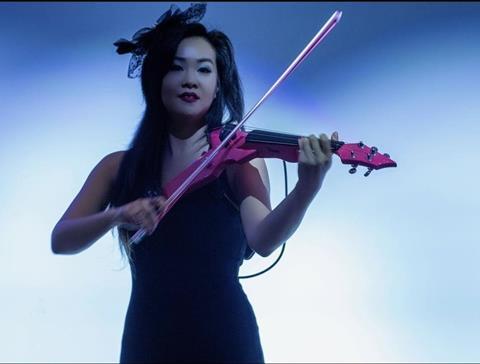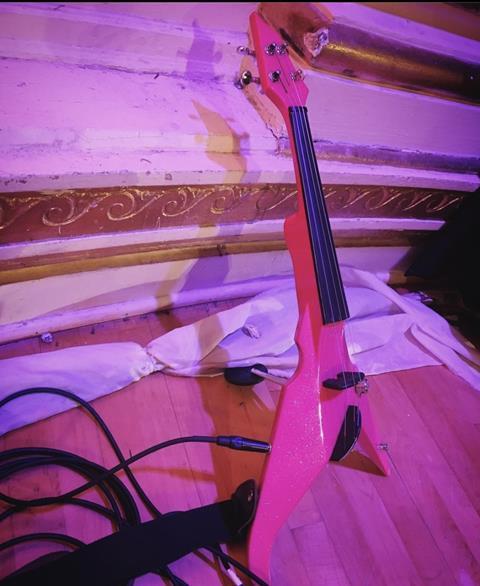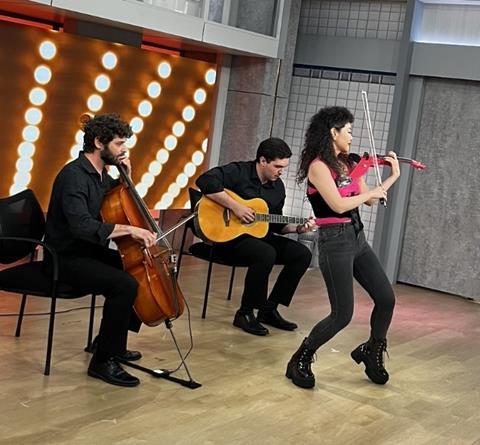Ahead of a plethora of summer shows, Judy Kang shares how playing an electric instrument helps her express herself more personally and creatively

Discover more Featured Stories like this in The Strad Playing Hub
What model/make of electric violin do you play?
I play on two Vipers by Wood Violins- a four-string and five-string.
What are some of the challenges of playing an electric violin, compared with a conventional acoustic violin?
I didn’t notice any immediate differences or challenges. It is a bit larger than a full size acoustic, so the spacing of the notes was a bit of an adjustment in particular because my hands are a bit on the smaller side. It is a bit heavier in weight but hangs on the chest area versus the arms.

Has playing electric violin informed the way you play acoustic violin in any way?
Not really. I suppose it’s common to immediately associate an electric to rock/pop/anything outside of the classical realm. When I had first started on the Viper, I was on a pop tour and had my Stradivari violin (on loan from The Canada Council) with me. In between the shows on the Viper, I was prepping for classical concerts I had in between, with the acoustic. For this particular artist, I didn’t have to make too many drastic changes in style, even though I was playing pop. I was essentially playing ’classically’ while adapting and experimenting with different sounds that worked with the vibe of each specific song.
Playing electric violin invites an accumulation of more gear - what are some of your favourite ways to manipulate sounds?
I enjoy contrasts and love the idea of utilising them simultaneously - chaotic, industrial, loud, concrete, dark, disruptive, dissonant noise versus natural, organic, lyrical, pretty, light, harmonic, pure, peaceful sounds. Sometimes I like to experiment with sound without the use of FX pedals or such; I like to physically feel how I’m producing it directly from the bow, arms, hands, fingers, etc. It is more organic and controlled in a sense, allowing me to create sounds more spontaneously.
Experimenting with pedals opens up endless possibilities of sounds outside of the realm of the violin/strings and allows for an electric to layer and create a symphony of melodies, harmonies, and dissonance simultaneously on one instrument. For instance, I love beats and rhythms and FX pedals could trigger a bow stroke to sound like a drum. It really opens our minds and ears to create a new world of sounds. The contrasts of noise and ’beauty’ could be explored and produced simultaneously via effects, whereas on an acoustic, those possibilities are limited.
Read: The Strad guide to the best handmade electric violins
Read: Electric instruments can be helpful tools for group string teaching

How has playing electric violin enabled you to explore different styles and a range of collaborations in your music making? Would you be doing what you do now if you played only acoustic violin?
It has definitely opened doors to playing with more bands, collaborations with diverse artists, solo events, many interesting projects, and utilising it in different contexts outside of the concert/music venue as well. I also find it enhances my experience as a classical artist and allows me to showcase myself more fully creatively and personally. I’ve always felt that there are many dimensions to being an artist and to express on one instrument isn’t enough for me personally. If not on an electric, I express through other outlets such as movement and dance, and visuals/film. I would still continue to play acoustic as it is a form of expression on a deep level authentic to me.
Judy Kang will be playing with ‘The Judy Kang Experience’ at festivals and shows across New York and New Jersey this summer. Kang will be accompanied by Dan Kassel on cello and Jake Valois on drums and guitar. For more information, visit judykang.com
Read: Johannes Moser: Surrounded by sound
Read: Pickup or microphone? Choosing what’s right for your bowed string instrument
Read more Featured Stories like this in The Strad Playing Hub
The number one source for playing and teaching books, guides, CDs, calendars and back issues of the magazine.
In The Best of Technique you’ll discover the top playing tips of the world’s leading string players and teachers. It’s packed full of exercises for students, plus examples from the standard repertoire to show you how to integrate the technique into your playing.
The Strad’s Masterclass series brings together the finest string players with some of the greatest string works ever written. Always one of our most popular sections, Masterclass has been an invaluable aid to aspiring soloists, chamber musicians and string teachers since the 1990s.
This year’s calendar celebrates the top instruments played by members of the Australian Chamber Orchestra, Melbourne Symphony, Australian String Quartet and some of the country’s greatest soloists.





































No comments yet